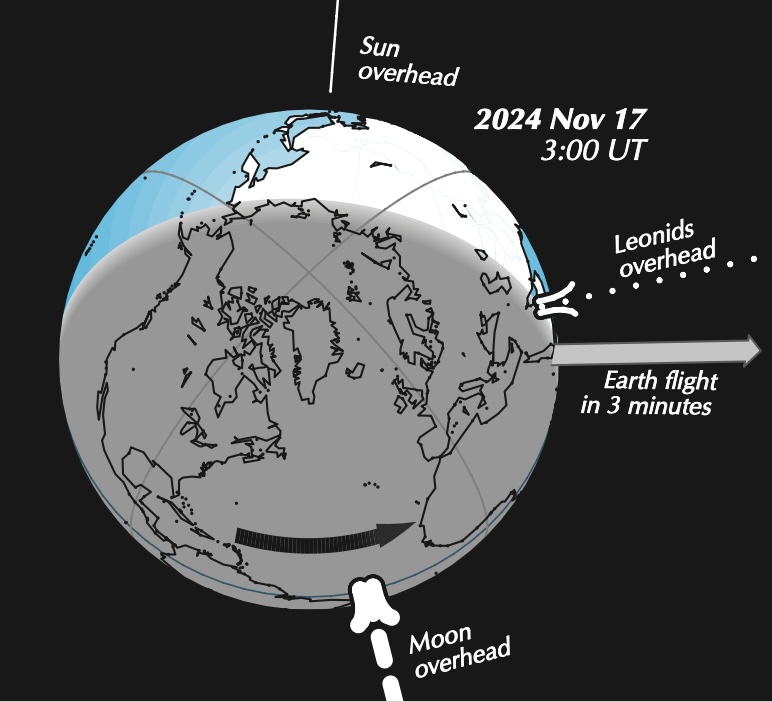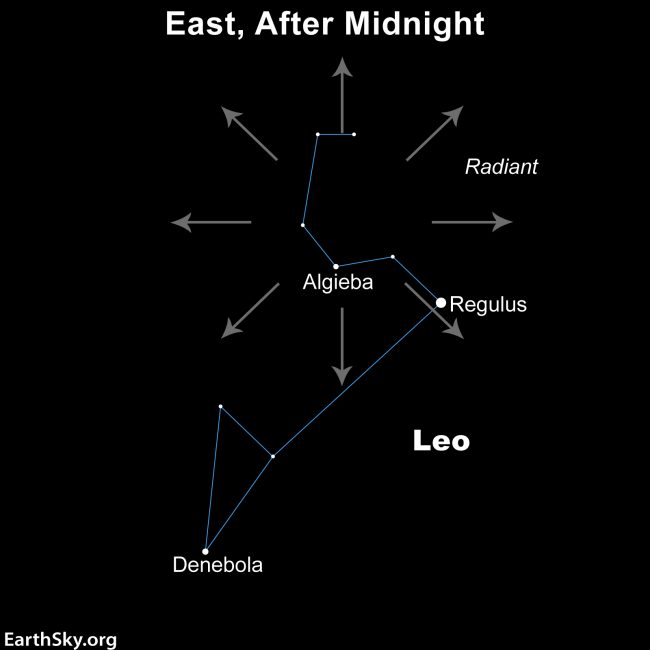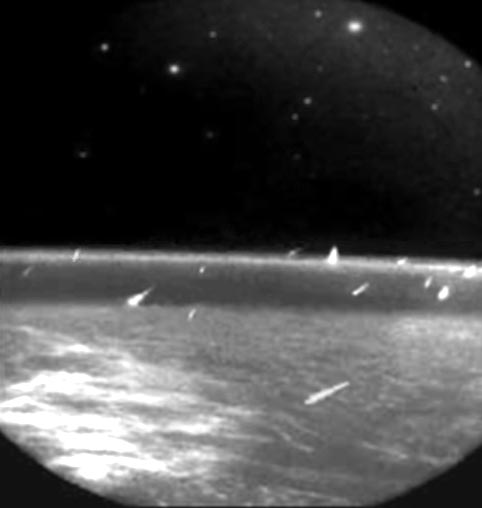
In 2024, the famous Leonid meteor shower will compete with moonlight from a waning gibbous moon on the shower’s peak morning, November 18. You might also try watching on the morning of November 17.
Mid-November meteors … the Leonids
Predicted peak: The peak is predicted** for November 18, 2024, at 5:00 UTC.
When to watch: Watch late on the night of November 17 until dawn on November 18. The morning of November 17 might be worthwhile, too.
Duration of shower: November 3 through December 2.
Radiant: Rises around midnight, highest in the sky at dawn.
Nearest moon phase: In 2024, the full moon falls at 21:29 UTC on November 15. So the bright waning gibbous moon will wash out some meteors in 2024.
Expected meteors at peak, under ideal conditions: Under a dark sky with no moon, you might see 10 to 15 Leonid meteors per hour.
Note: The famous Leonid meteor shower produced one of the greatest meteor storms in living memory. Rates were as high as thousands of meteors per minute during a 15-minute span on the morning of November 17, 1966. That night, Leonid meteors did, briefly, fall like rain. Some who witnessed it had a strong impression of Earth moving through space, fording the meteor stream. Leonid meteor storms sometimes recur in cycles of 33 to 34 years. But the Leonids around the turn of the century – while wonderful for many observers – did not match the shower of 1966. And, in most years, the Lion whimpers rather than roars.
Read more: All you need to know about Leonid meteors
Report a fireball (very bright meteor) to the American Meteor Society: it’s fun and easy!
Find a place to watch at EarthSky’s Best Places to Stargaze page.
The parent comet of the Leonid meteor shower
From the late, great Don Machholz (1952-2022), who discovered 12 comets …
Periodic Comet Tempel-Tuttle, officially known as 55P/Temple-Tuttle, is responsible for the Leonid meteor shower. William Tempel of Marseilles Observatory in France discovered this comet on the evening of December 19, 1865. He found the comet in the northern sky, located in a part of the sky under the North Star, near the star Beta Ursae Minoris.
Word of the comet discovery became known throughout Europe, but the news had not yet spread to the United States. Horace Tuttle of Harvard College Observatory picked up the comet 17 days later, on the evening of January 5, 1866. Because this was an independent discovery, Tuttle’s name was added to the comet. Based upon the measurements during this visit of the comet, scientists calculated an orbit of 33.17 years. Astronomers quickly realized that the meteor storms and showers which occurred in mid-November of each year were the result of this comet.
One would think that there would be great interest in recovering this comet as it came back to the earth’s vicinity in 1899. But there wasn’t much interest in seeing the comet, everyone wanted to see a meteor storm. So, observers missed the comet in 1899. Also missing was a great meteor shower that year.
Scientists expected the next return in 1932. The observatories, using photographic plates with narrow field-of-view telescopes, missed it then too. And again, a major meteor shower did not materialize.
The comet was recovered in 1965
The comet was finally recovered in 1965. The brightest the comet got that year was 16th magnitude, visible only in very large telescopes. A spectacular meteor storm followed in 1966. On the next return, in early 1998, the comet was bright enough that you could see it in binoculars. This pass produced additional impressive meteor showers in 1999-2001. 55P/Temple-Tuttle is due back in early 2031.
With so much anticipation with the 1998 return and the expected meteor storms, several astronomers calculated the exact time and intensity of the storm. And they were accurate. This was the first instance of correct predictions. It is done by analyzing filaments of material expelled from each trip of the comet through the inner solar system. Quite often, a filament left behind by the comet hundreds of years ago will intersect the earth and produce a fabulous shower.
The Leonids: a meteor shower that revolutionized meteor science.
Note: This article, Leonids 1901-2100, gives specific meteor predictions for each year for this shower from the year 2001 to 2100.
The radiant of the Leonids


Which direction should I look to see the Leonid meteor shower?
Meteors in annual showers get their names from the point in the starry sky from which they appear to radiate. This shower’s name comes from the constellation Leo the Lion, because these meteors radiate outward from the vicinity of stars representing the Lion’s Mane.
If you trace the paths of Leonid meteors backward on the sky’s dome, they do seem to stream from near the star Algieba in the constellation Leo. The point in the sky from which they appear to radiate is the radiant point. This radiant point is an optical illusion. It’s like standing on railroad tracks and peering off into the distance to see the tracks converge. The illusion of the radiant point comes from the fact that the meteors – much like the railroad tracks – are moving on parallel paths.
In recent years, people have gotten the mistaken idea that you must know the whereabouts of a meteor shower’s radiant point in order to watch the meteor shower. You don’t need to. The meteors often don’t become visible until they are 30 degrees or so from their radiant point. They are streaking out from the radiant in all directions.
Thus, the Leonid meteors – like meteors in all annual showers – will appear in all parts of the sky.

A history of meteor storms
Scientists don’t expect a Leonid meteor storm this year. Most astronomers say you need more than 1,000 meteors an hour to consider a shower a storm. That’s far from the 10 to 15 meteors per hour the Leonids deliver in average years.
The Leonid shower is famous for producing meteor storms, though. The parent comet, Tempel-Tuttle, completes a single orbit around the sun about once every 33 years. It releases fresh material every time it approaches the sun. Since the 19th century, skywatchers have looked for Leonid meteor storms about every 33 years, beginning with the meteor storm of 1833, which witnesses said produced more than 100,000 meteors an hour.
The next great Leonid storms were about 33 years later, in 1866 and 1867. In 1899, a meteor storm did not materialize. In fact, the anticipation of a great meteor storm was so high, and the results so disappointing, that many astronomers felt it was the worst blow ever suffered by astronomy in the eyes of the public.

Some Leonid meteor storms last century
Not until 1966 did the next spectacular Leonid storm occur, this time over the Americas. In 1966, observers in the southwest United States reported seeing 40 to 50 meteors per second (that’s 2,400 to 3,000 meteors per minute) during a span of 15 minutes on the morning of November 17, 1966.
In 2001, another great Leonid meteor storm occurred (though not as great as 1966). Spaceweather.com reported:
The display began on Sunday morning, November 18, when Earth glided into a dust cloud shed by Comet Tempel-Tuttle in 1766. Thousands of meteors per hour rained over North America and Hawaii. Then, on Monday morning November 19 (local time in Asia), it happened again: Earth entered a second cometary debris cloud from Tempel-Tuttle. Thousands more Leonids then fell over East Asian countries and Australia.
View SpaceWeather’s 2001 Leonid meteor gallery.

The Leonid meteor shower of 1833
Adolf Vollmy produced the famous engraving above of the 1833 Leonid meteor shower for the Adventist book “Bible Readings for the Home Circle.” It’s based on a painting by Swiss artist Karl Jauslin, which, in turn, was based on a first-person account of the 1833 storm by a minister, Joseph Harvey Waggoner, who saw the 1833 shower on his way from Florida to New Orleans.
In that famous shower, hundreds of thousands of meteors per hour fell. It was the first recorded meteor storm of modern times.
Leonid meteors from the EarthSky Community

Bottom line: In 2024, watch for Leonids after midnight until dawn on November 18. The radiant point rises around midnight and is highest in the sky at dawn. A waning gibbous moon will interfere with Leonid meteors this year.
**Predicted peak times and dates for meteor showers are from the American Meteor Society. Note that meteor shower peak times can vary.
EarthSky’s meteor shower guide for 2024











